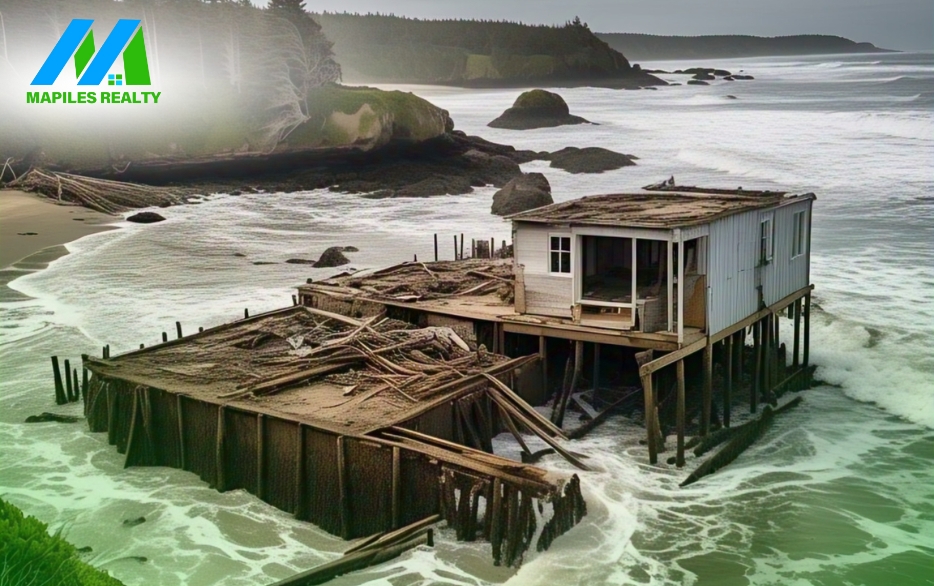Climate change is having a profound impact on coastal properties around the world. Rising sea levels, increased flooding, and more frequent natural disasters are all threatening the value and stability of coastal real estate. In this article, we’ll assess the risks and mitigation strategies for coastal properties in the face of climate change.
Coastal properties are highly prized for their scenic views, recreational opportunities, and often, high property values. However, these same properties are also highly vulnerable to the impacts of climate change. Rising sea levels are causing more frequent and severe flooding, while increased storm intensity is leading to more frequent and destructive natural disasters.
One of the most significant risks facing coastal properties is sea level rise. As the planet warms, melting glaciers and ice sheets are causing sea levels to rise. This is leading to more frequent and severe flooding, particularly during high tides and storms. In addition, sea level rise is also causing erosion and saltwater intrusion into freshwater sources.
Another significant risk facing coastal properties is increased storm intensity. Climate change is leading to more frequent and intense storms, which can cause catastrophic damage to coastal properties. Storm surges, heavy rainfall, and strong winds can all cause significant damage to buildings, infrastructure, and the environment.
In addition to these physical risks, climate change is also having an impact on the economic value of coastal properties. As the risks associated with climate change become more apparent, property values are likely to decline. This can have significant economic implications for property owners, investors, and local communities.
So, what can be done to mitigate the impacts of climate change on coastal properties? One strategy is to implement adaptation measures, such as sea walls, levees, and flood-proofing. These measures can help protect properties from flooding and storm damage.
Another strategy is to implement resilience measures, such as elevating buildings, using flood-resistant materials, and designing buildings with storm resilience in mind. These measures can help reduce the risk of damage from flooding and storms.
In addition to these physical measures, there are also economic and policy measures that can be implemented to mitigate the impacts of climate change on coastal properties. For example, governments can implement policies to discourage development in high-risk areas, or to require property owners to implement adaptation and resilience measures.
Insurance companies can also play a role in mitigating the impacts of climate change on coastal properties. By offering flood insurance and other climate-related insurance products, insurance companies can help property owners manage the risks associated with climate change.
Finally, individuals can also take steps to mitigate the impacts of climate change on coastal properties. For example, property owners can implement adaptation and resilience measures, such as elevating buildings or using flood-resistant materials. Individuals can also support policies and initiatives that aim to mitigate the impacts of climate change on coastal properties.
In conclusion, climate change is having a profound impact on coastal properties around the world. Rising sea levels, increased flooding, and more frequent natural disasters are all threatening the value and stability of coastal real estate. However, by implementing adaptation and resilience measures, economic and policy measures, and individual actions, we can mitigate the impacts of climate change on coastal properties.
As the impacts of climate change continue to evolve, it’s essential that we stay informed and take proactive steps to mitigate its effects. By working together, we can reduce the risks associated with climate change and protect the value and stability of coastal properties for generations to come.
The Philippines, being an archipelago, is highly vulnerable to the impacts of climate change. Rising sea levels, increased flooding, and more frequent natural disasters are all threatening the value and stability of coastal properties in the country. However, by implementing adaptation and resilience measures, economic and policy measures, and individual actions, we can mitigate the impacts of climate change on coastal properties in the Philippines.
In the Philippines, the government has implemented various initiatives to mitigate the impacts of climate change on coastal properties. For example, the government has established the Climate Change Commission, which is responsible for coordinating the country’s climate change efforts. The government has also implemented policies to discourage development in high-risk areas and to require property owners to implement adaptation and resilience measures.
In addition to these government initiatives, individuals and the private sector can also play a role in mitigating the impacts of climate change on coastal properties in the Philippines. For example, property owners can implement adaptation and resilience measures, such as elevating buildings or using flood-resistant materials. The private sector can also invest in climate-resilient infrastructure and support initiatives that aim to mitigate the impacts of climate change on coastal properties.
In conclusion, climate change is having a profound impact on coastal properties in the Philippines. However, by implementing adaptation and resilience measures, economic and policy measures, and individual actions, we can mitigate the impacts of climate change on coastal properties in the country. It’s essential that we work together to reduce the risks associated with climate change and protect the value and stability of coastal properties in the Philippines.





